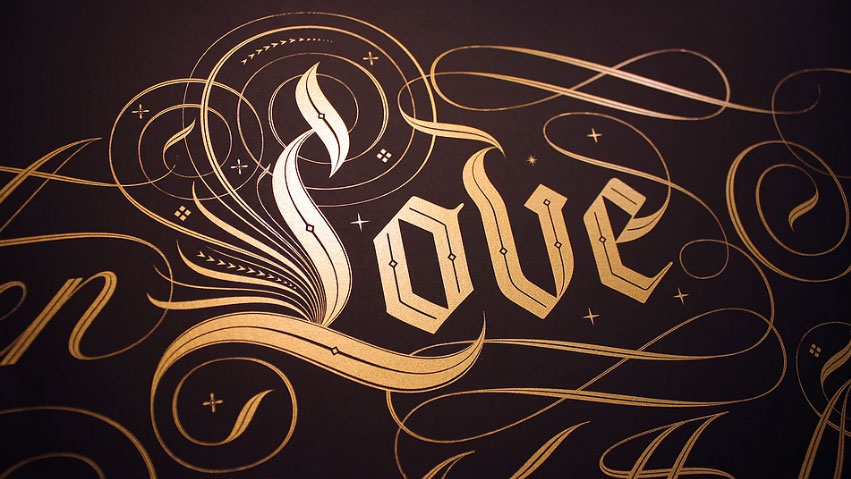How to get a million followers on Instagram
Typographer Seb Lester explains how he gained a massive following with his strangely satisfying Instagram videos.

Seb Lester has designed logos and typographic illustrations for some of the world’s biggest companies – from Nike and Intel to NASA. However, despite the fact that millions of people had seen his work, he remained relatively unknown as a designer. That was until he began sharing sped-up videos of his hand-lettering work on his Instagram feed, and suddenly everyone knew his name. Follower numbers shot up (he’s now racked up some 1.1 million), and he became the first visual artist to be offered a one-year contract by Apple.
Last week, Lester wowed the audience with his work at Reasons.to, an award-winning festival of design and code held annually in Brighton, UK. We caught up with him after his talk to hear his tips for mastering social media.
01. Instagram isn’t just for digital art
Although Lester now often posts digital design work, it was his traditional calligraphy that sent his profile soaring. “It’s amazing how well calligraphy translates to the internet,” he says. “You’ve got this ancient artform but it really does translate very well.”
A photo posted by @seblester on Jul 3, 2018 at 8:30am PDT
Lester muses over whether the widespread popularity of his videos is due to the fact that they fit into the 'strangely satisfying' category of online content, of which people just can’t seem to get enough. “There’s something satisfying about seeing something from beginning to end,” he explains. “A blank piece of paper and then something appearing.”
02. Don’t just talk to other designers
The great thing about apps like Instagram – as opposed to design-specific platforms such as Behance – is that you can reach a whole audience of people who don’t have anything to do with the creative industries. “I love the fact that a lot of my followers are people who are hairdressers or bakers or just don’t work in the visual arts or study the visual arts. I consider that a really lovely thing,” says Lester. “People who never really thought about calligraphy and then suddenly they’re seeing something they find compelling.”
03. Find something relatable
Lester’s latest thing is his Logo Doodles: short, time-lapse videos in which he recreates well-known logos on an iPad Pro. He points out that the thing with logos is that they’re immediately relatable, which makes them a great way to catch people’s attention.
A post shared by Seb Lester (@seblester)
A photo posted by on on Aug 30, 2018 at 5:24am PDT
He recognises that this widespread appeal is what makes his logo work more universal than his other love: heraldry. “I can get incredibly nerdy talking about 7th century Pictish knotwork. People might think its weird or beautiful looking but it's not really part of their world. Whereas a logo for, say, Netflix is completely, immediately,” he smiles.
Daily design news, reviews, how-tos and more, as picked by the editors.
04. Keep it fun
There’s nothing too complex about these films: Lester captures them using a tripod and DSLR, but acknowledges that he could now probably use his phone camera instead. He thinks the low-fi look is all part of the charm. “It’s like a little magic trick. That's really what those little short-form things are; little stunts,” he says. “They're just fun. It's not high art or anything. Just fun, pop arty stuff.”
He continues: "You can do amazing illustration with literally a biro and a piece of notepaper and create something incredibly viral from that, and I have done in the past. It's good to be open."
05. Take advantage of new tools
Although Lester can indeed create masterpieces with traditional pens, he's also happy to embrace the latest digital tools. “I'm not going to be a luddite and ignore technology. The best artists and calligraphers in history have always sought out the best tools,” he points out. “I'm absolutely positive Dürer would have been blown away by digital technology. He'd be entranced. Da Vinci. I'm sure they'd love it.”
A photo posted by @seblester on Jul 22, 2018 at 9:46am PDT
The most powerful thing about the new digital tools, he says, is their ability to automate parts of the drawing process, including mirroring, and rotational and reflective symmetry. These features can take the pain out of drawing incredibly complex forms, such as Lester’s heraldry work.
06. Don’t underestimate social media...
When he first joined Instagram, Lester didn’t realise quite the potential it would have to open doors in his career. Now he acknowledges the importance of such platforms for artists and designers. “You need a social presence those days, whether you want it or not,” he comments. “I don't think people look at people's websites as much as they look at their social media these days.”
With that comes a little more responsibility. “You've got to be really careful what you say. It's publishing in a sense,” he adds.
07. … but don’t overthink it
While being aware that you’re not just talking to your immediate friends is important, getting caught up in how far your posts could reach is a risky business. Lester prefers to approach social media as a kind of computer game.
“If I start thinking there are actual people behind these avatars, who are watching what I'm doing, I’d find it very debilitating," he explains. "It's actually quite surprising when people come up to me and say they follow me on Instagram and it's actually a real, physical person."
To avoid total paralysis, he takes his cues from friend and YouTube sensation Casey Neistat, whose show he appeared on in 2015 (above). “Casey says you just have to get on with it, just do it. He's right when it comes to this sort of thing. Think a little bit but not too much.”
Read more:

Ruth spent a couple of years as Deputy Editor of Creative Bloq, and has also either worked on or written for almost all of the site's former and current design print titles, from Computer Arts to ImagineFX. She now spends her days reviewing small appliances as the Homes Editor at TechRadar, but still occasionally writes about design on a freelance basis in her spare time.
